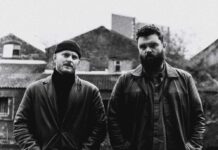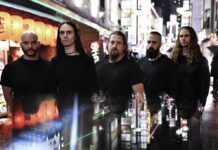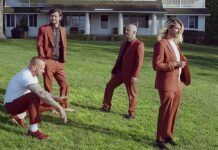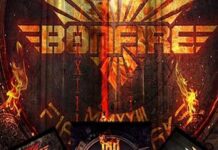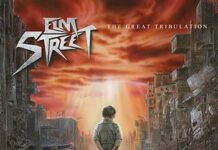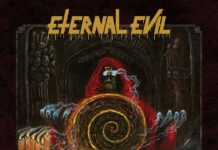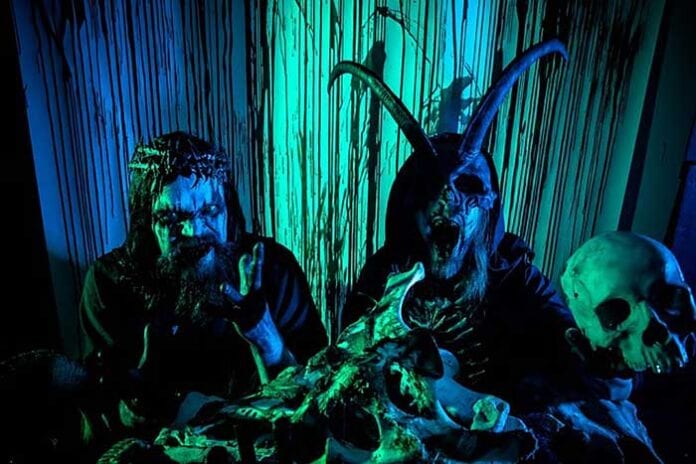
INTERVIEW WITH ANDERS ODDEN BY GEORGE PACHECO
PHOTOGRAPHS BY HANNAH VERBEUREN
The cult is alive with the latest reunion release from Norway’s Cadaver. Edder & Bile is the band’s first collection of new material since 2004’s Necrosis and is a welcome return to form for one of the pioneering Scandinavian death metal bands of their day. The band was a breath of fresh (or is that fetid?) air from the days just prior to the Norwegian black metal explosion of the mid to late 90s, and the years have been extremely kind to Cadaver’s dark, intense, and moody brand of Voivod-ian extreme metal.
Instrumentalist and songwriter Anders Odden has always been a forward-thinking sort of musician, and it was a pleasure for us to speak with him one brisk winter morning to discuss the years past and future for one of Norway’s best kept musical secrets.
Cadaver always stood out, even the first two records, with regards to what was going on in the States with death metal, as well as in Europe. Did you always feel like you were coming from another place musically, and did this filter into Edder & Bile at all?
Yeah, I tried to figure out what I was doing back then before I started writing stuff for this record, and one thing I did was to try to go back and figure out what I was doing on my old material, to try and figure out where I was coming from a little bit. I think it’s always been the same. Myself and the other guys in Cadaver were inspired by a mix of extreme metal, and as such, we always had a little bit of everything in it. It’s an easy way of saying we were on our own planet. We didn’t follow any specific trend of the time. We just did our own thing.
“WE ALWAYS HAD A LITTLE BIT OF EVERYTHING IN IT. IT’S AN EASY WAY OF SAYING WE WERE ON OUR OWN PLANET.”
I actually just put together a playlist for a radio show, the kind of music that formed me. Whenever I do that, there’s always enough variety in the list. I have stuff from the Bay Area thrash scene, stuff from the Swedish scene like Bathory, and European thrash like Kreator and Sodom. The British grindcore stuff with Carcass and Napalm Death, and the secret stuff, I guess you could say, we had with our original drummer, who was into hardcore stuff like D.R.I. and Carnivore. We were also really into Voivod, so this whole thing being where we were taking inspiration to this small little Cadaver island led us to where we ended up.
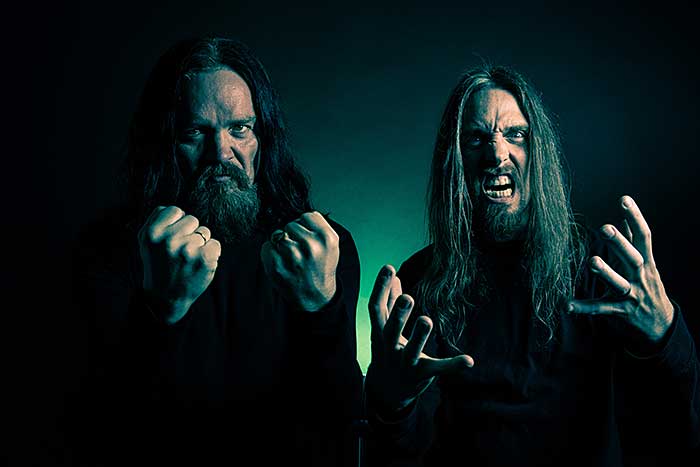
Do you remember the early days of when you discovered extreme metal? How did this love of extremity come to you when you were younger?
Well, there were two very important incidents in my early years. One was when I discovered all the extreme metal at the time from this one album, Speed Kills [1985]. On that record there were songs from Possessed, Destruction, Exodus, Slayer, Metallica, Megadeth, Venom, Celtic Frost, Voivod, Exciter, Bulldozer from Italy, and Hallows Eve. I discovered all of those bands on the same day, opening me up to bands I never knew existed. I was digging deep into that, and soon enough there was a band in Norway doing this exact kind of music called Mayhem, but this was very early in their career.
Mayhem was known in the underground scene with the Pure Fucking Armageddon tape. I was probably 14-years-old at the time, and they were like 17. We were all really young kids, and I convinced Mayhem to invite me to their rehearsal space. So, I went and saw them rehearse before they even had a record, and seeing Mayhem in the room as a kid made me want to form a band just like them. So, Mayhem is my blueprint for anything with regards to extreme metal. They had a different style, too. They’re the forefathers of the Norwegian black metal stuff, but they also mixed influences from avant-garde stuff like Krautrock music, with Conrad Schnitzler from Tangerine Dream doing their intro. They always had this variety in their framework, and to this day those original Mayhem guys are some of my closest friends. These were the most formative people for introducing me to extreme metal.
“IT’S NEVER BEEN ABOUT DOING ANYTHING ELSE BUT BEING ORIGINAL. STANDING OUT WAS MORE IMPORTANT TO ME THAN ANYTHING ELSE. THAT’S WHERE MY HEART AND SOUL IS.”
Hallucinating Anxiety came out in 1990, and at that time Darkthrone, Amputation, and a lot of the future Norwegian black metal bands were still doing death metal. What was the feeling in Norway when Cadaver and the early incarnations of bands like Immortal and Satyricon were doing death metal before the big explosion of what would become Norwegian black metal a few years later?
It was basically just one scene. Some people think that death and thrash metal had different scenes in Norway, but the country’s not big enough for that! (laughs) It’s the same people, and they all loved different things. They lied when they said they only listened to this one thing, that’s never been the case! They just found a source of originality to appreciate, and at that time our heads were going a different way. For our …In Pains [1992] album, we had a production value that would be appreciated by people maybe 10 or 15 years later. That’s the story of my life—way too early or ahead of my time! It’s never been about doing anything else but being original. Standing out was more important to me than anything else. That’s where my heart and soul is.
Did that desire to stand out influence …In Pains specifically? I listened to that album again yesterday and I was struck by how challenging it is, even today.
If we were a Swedish band doing that record at the time, we’d probably be much bigger. Swedish people have always had the business knowledge side of things with them. The Norwegian bands never had that going for them, we just shot from the hip. We didn’t really know that we were supposed to have managers and booking agents, and that’s the key difference in the early days. Those Swedish bands had the support from the music industry at the time, and we did not. No one cared about this kind of music in the industry here. When we tried to do things at that time, it seemed impossible to even go on tour. There was no such thing as infrastructure for what we were doing, so we obviously gave up too soon.
“AS A SONGWRITER YOU’RE TRYING TO FIND YOUR SOURCE, AND IF YOU DO THAT, THE RESULTS CAN BE ALMOST LIMITLESS.”
When the Cadaver Inc. record came out, the black metal influences were creeping in at that time. Do you feel any connection with Cadaver Inc. and Edder & Bile, or do you feel those are two separate periods?
I feel like they’re two separate periods. With this record, I was going more for a missing link between Hallucinating Anxiety [1990] and …In Pains,with better production. That’s just a figure of speech so many years later, though. I rediscovered what I feel is my musical voice without leaning on any other bands than this band. So, if I’m ripping off myself, then that feels like even the better thing to do, if that makes things sound more original. Our inspiration was very diverse at the time anyway. As a songwriter you’re trying to find your source, and if you do that, the results can be almost limitless. We already have another new record’s worth of material written. The way the world is right now, that one will be written sooner rather than later, and I’m anxious to see where that takes me.
Edder & Bile is short in comparison to albums these days, but it has that Reign in Blood feeling where the first time I listened to it, it was over so quickly. I wanted to listen to it again.
Exactly. That’s your answer! (laughs)
Was that the intention? To trim the fat and make sure the songs weren’t too long and bloated?
Yeah, because for us it’s more interesting to have this punch in the face feeling, and besides, there are also enough layers to it that I feel the songs have more to offer with subsequent listens. I really wanted to get that feeling over.
How was it collaborating with Dirk Verbeuren for this record?
His collaboration is the whole reason why I’m doing this again, because his enthusiasm and abilities make me better at what I do. He’s literally the top five best drummers in the world, so to have him doing this, it’s key. He’s making it so much more exciting for me to write music. It goes back and forth. If you want your art to be inspired, you take your inspiration from the art.
With people getting their music digitally, the visual presentation of an album can be lost. Not this one, however. Before I heard a note of the new record, I was immediately impressed with the overall visual aesthetic. What inspired the look of Edder & Bile?
Like you said, most people listen to streaming services or digital files now anyway, regardless, including the vinyl people. However, to have this physical piece on LP is really great, because you can actually fit artwork that possesses greater detail. That’s one aspect of CDs I never liked, the lack of space for artwork. It’s too small, and anything you try to do becomes too minimized. To have that back is great, and I really wanted this vibe of a lost era. It was a magical aspect of music for me when I was a kid. Bands like KISS, Venom, Motörhead, and W.A.S.P., they emphasized the physical package in a way that made you mesmerized. It left a lot of fantasy up for the listener, taking in the images with the music, increasing the bond you make with the music.
“IT’S NOT BLACK METAL. IT’S ACTUALLY EVERYTHING. GET YOURSELF EDUCATED.”
I’m 47-years-old, and some people I know have commented about “dressing up” and they just don’t understand what I’m trying to do. It’s probably not for them, anyway. We didn’t get into metal because we saw people who looked like teachers. That’s not the excitement for metal. It’s presenting a different world entirely. That’s not linked to one genre of metal, either. That’s the key. It’s not black metal. It’s actually everything. Get yourself educated. People probably wouldn’t like artists like Alice Cooper without the theatrics. I think that having a persona is deep within the soul of this music.
You mention being educated, and I wanted to ask whether you still did the Norwegian black metal tours in Norway?
No, I know that it’s out there, but I actually haven’t done that since 2012, because I realized that with Euronymous being my mentor, and him being killed was such a huge loss. It made me do other things and listen to other stuff and not be a part of the scene for a couple years. There was just too much bullshit and too much hardship. When I did that, at the time a lot of the mythmaking was still going on, and even today that Lords of Chaos movie is still doing that. Somehow the whole idea of people thinking that all these kids in Norway did this to become famous is radically the opposite of what was going on. All this stuff like, “Oh, I wish we had started a black metal band, that would’ve gone over really well.” That wasn’t really what anyone thought or said or did. That wasn’t the intent at all. It wouldn’t have been allowed! (laughs)If it was catching on, someone would’ve said, “Oh, this is trendy now? Fuck this!” (laughs) That’s the whole point, but that’s left out of the conversation. It’s like, don’t you realize that these people were doing what was in opposition to what was popular? That was key. Now it seems like everybody was doing it to flip that coin to make it, and that’s radically wrong.


